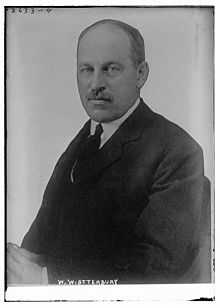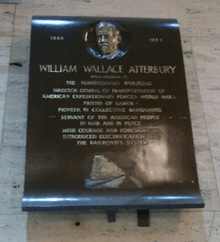William Wallace Atterbury
| William Wallace Atterbury | |
|---|---|
 | |
| c. 1913 | |
| Member of the Republican National Committee from Pennsylvania | |
| In office May 12, 1928 – October 10, 1930 | |
| Preceded by | George Pepper |
| Succeeded by | Jay Cooke |
| Personal details | |
| Born | January 31, 1866 New Albany, Indiana |
| Died | September 20, 1935 Philadelphia, Pennsylvania |
| Political party | Republican |
| Spouse(s) | Matilda Hoffman of Fort Wayne, Ind. (November 13, 1895 – her death in 1910) Arminia (Rosengarten) MacLeod (June 10, 1915 – his death) |
| Children | three McLeod children he adopted William W. Atterbury, Jr. |
| Alma mater | Sheffield Scientific School (1886) |

William Wallace Atterbury (January 31, 1866 – September 20, 1935)[1][2] was an American Brigadier General during World War I. He was instrumental in reorganizing railroad traffic during the war for more efficient transportation of troops and supplies for the American Expeditionary Forces. After the war, he became the tenth president of the Pennsylvania Railroad (PRR) (1925–1935). He was a leader in pushing to electrify portions of the PRR.
Biography
Atterbury was born in New Albany, Indiana. He attended Yale University, Class of 1886, where he was a member of the Chi Phi Fraternity. He was a Pennsylvania delegate to the 1920 Republican National Convention.
He started as an apprentice in the Pennsylvania Railroad shops at Altoona for five cents/hour.[2][3] In 1925, he succeeded Samuel Rea as president of the PRR, a position he held until he retired in 1935.
Atterbury was also active in Republican State politics. In 1928,[4] he was elected the state's Republican National Committeeman, though he resigned from the post two years later in opposition to Gifford Pinchot's gubernatorial candidacy.[5]

Awards and decorations
For his work he was awarded: Distinguished Service Medal, Commander of the Legion of Honor (France); Companion of the Most Honorable Order of the Bath (England); Commander of the Royal Order of the White Eagle (Serbia), and Grand Officer of the Order of the Crown (Romania).[6]
Legacy
Camp Atterbury in Edinburgh, Indiana, is named for him, as was, for a time, Atterbury Army Airfield.
See also
References
- ↑ "Noted rail head, native of city" (PDF). New Albany Tribune. September 21, 1935. Retrieved 2011-06-26. cited at New Albany Floyd County Public Library.
- ↑ 2.0 2.1 "William Wallace Atterbury". Dictionary of American Biography (FEE, VIA FAIRFAX COUNTY PUBLIC LIBRARY). New York: Charles Scribner's Sons. 1944. Gale Document Number: GALE|BT2310018570. Retrieved June 26, 2011. Gale Biography In Context.
- ↑ "Business: Atterbury for Rea". Time (magazine). September 28, 1925. Retrieved 2011-06-26.
- ↑ "Pepper Refuses Place As Contest Chairman". The Baltimore Sun. June 1, 1928. Retrieved January 22, 2012.
- ↑ "Atterbury Bolts Pinchot Candidacy". The New York Times. October 10, 1930. Retrieved January 22, 2012.
- ↑ Indianamilitary.org
- Atterbury-Bakalar Air Museum (2000), General Atterbury. Retrieved February 21, 2005.
- The Political Graveyard (March 10, 2005), Politicians in Railroading in Indiana. Retrieved December 30, 2005.
- White, John H., Jr. (Spring 1986). America's most noteworthy railroaders, Railroad History 154, p. 9–15.
External links
| Wikimedia Commons has media related to William Wallace Atterbury. |
| Party political offices | ||
|---|---|---|
| Preceded by George Pepper |
Member of the Republican National Committee from Pennsylvania 1928–1930 |
Succeeded by Jay Cooke |
| Other offices | ||
| Preceded by Samuel Rea |
President of the Pennsylvania Railroad 1925–1935 |
Succeeded by Martin Clement |
|